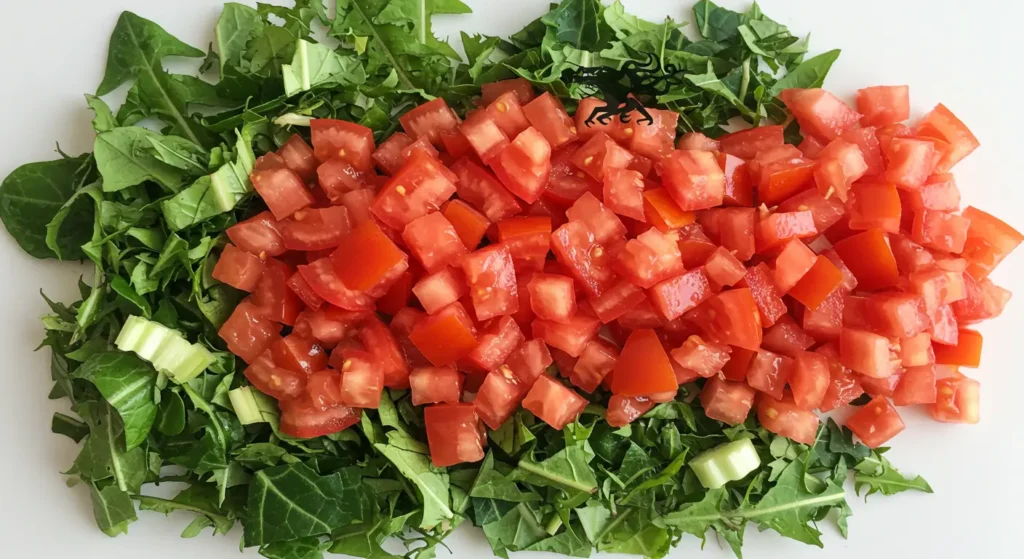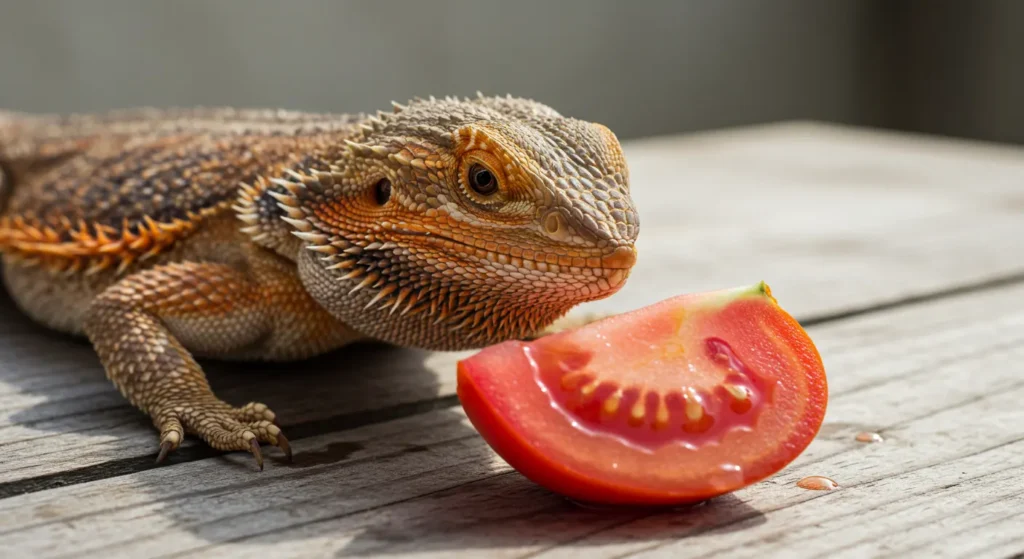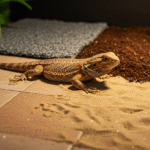Bearded dragon owners often ask: Can a bearded dragon eat tomatoes? This matters because tomatoes (Solanum lycopersicum) offer vitamins and hydration—but they also bring risks like acidity, calcium imbalance, and plant toxins.
In this guide, we’ll explore the pros and cons of feeding tomatoes and share expert tips. You’ll also find useful comparisons with other foods like Peaches and Asparagus. Curious about protein treats? See our section on Worms for a balanced diet plan.
By learning safe prep methods, ideal serving frequency, and potential warning signs, you’ll know can a bearded dragon eat tomatoes? responsibly—ensuring your dragon stays healthy and happy.
Can a bearded dragon eat tomatoes safely? Health benefits explained
Tomatoes can serve as a nutritious, hydrating treat for bearded dragons—when offered correctly. In this section, we’ll explore the key health benefits of tomatoes, including essential vitamins, hydration support, and dietary enrichment that can boost your dragon’s well-being.
High vitamins A & C: immune system support for beardies
Tomatoes are rich in vitamins A and C, two essential nutrients that actively support your bearded dragon’s immune system and overall health. Vitamin A plays a critical role in maintaining healthy vision, skin, and mucous membranes. Introducing adequate vitamin A through diet helps shield your dragon from respiratory infections and supports skin regeneration—essential during shedding periods. Meanwhile, vitamin C acts as a powerful antioxidant. It neutralizes free radicals that can damage cells, helping to reduce inflammation and boost immunity. Although bearded dragons synthesize some vitamin C naturally, supplementing via fresh foods like tomatoes adds an extra layer of protection—especially during stress or seasonal changes that could weaken their natural defenses.
When you serve a small, diced portion of ripe tomato, your dragon gets a natural dose of these beneficial vitamins without relying solely on supplements. Just keep in mind that tomatoes shouldn’t replace staple foods; instead, think of them as occasional nutritional support. A balance of insects, leafy greens, and calcium-rich veggies should make up the core of the diet. Offering tomatoes once every couple of weeks can help maintain a well-rounded nutrient profile and support a resilient immune system—particularly during the cooler months or breeding season when immune stress is more common.
Tomato water content: hydration and fluid balance
Tomatoes are approximately 95% water, making them an excellent hydrating snack for bearded dragons. Hydration plays a vital role in reptile health: it aids digestion, supports kidney function, and helps prevent potential issues like constipation or impaction. In warmer climates or during hot summer months, beardies lose more moisture through respiration and activity. Including a small portion of juicy tomato in their diet helps replenish fluid loss and reduce the risk of dehydration-related health problems.
Offering diced tomato pieces encourages your dragon to lick and nibble slowly—an ideal form of gentle hydration. This method mimics the natural hydration they’d receive in the wild from dew-covered fruits and plants. Make sure you use ripe tomatoes, as they contain more water and fewer harsh acids than unripe ones. You can also lightly mist leafy greens with diluted tomato juice to boost fluid intake subtly.
However, tomatoes should not be the main source of water. Always keep clean, fresh water available in a shallow dish. A multi-pronged hydration approach helps beardies thrive—using tomatoes for occasional moisture support and relying on water dishes to meet their daily needs. By combining both, you ensure optimal hydration, digestive health, and overall well-being.
Enrichment & diet variety: occasional tomato treats
Offering tomatoes can greatly enhance dietary enrichment for bearded dragons. Reptiles thrive not only on proper nutrition but also on mental stimulation that mimics their natural foraging behavior. The unique texture, sweet flavor, and bright color of tomato pieces engage your dragon’s senses and encourage active feeding. This kind of variety boosts engagement, reduces boredom, and contributes to overall well-being—especially in captive environments where enrichment opportunities are limited.
To introduce tomatoes as treats, offer just one teaspoon of finely diced, ripe tomato every 10–14 days. This small serving acts as a novel snack without disrupting dietary balance. Backed by your turtle tank routine, this routine treat creates a positive experience. It can help condition your dragon to look forward to feeding time, improving appetite for essential staples like leafy greens and insects.
Keep a feeding log to track reactions and preferences—chances are, your dragon will show increased interest thanks to the new taste profile. Rotate this treat with other safe fruits like melon or berries to maintain variety. Just ensure you stay within treat limits so caloric intake stays controlled and nutrient balance is maintained. Small, occasional tomato treats enrich both mind and body in a controlled, beneficial way.
Nutrient comparison: tomatoes vs staple greens
While tomatoes offer hydration and vitamins, they fall short in calcium content—a nutrient cornerstone for reptile bone and shell health. Many staple leafy greens like collard, mustard, or dandelion boast high calcium-to-phosphorus ratios (well above the 2:1 calcium preference recommended for bearded dragons). These greens support strong bone development and combat metabolic bone disease. In contrast, tomatoes have low calcium levels and higher phosphorus, which can negatively affect nutrient absorption if overused.
Rather than offering tomatoes or greens exclusively, pair them thoughtfully. For instance, serve a small teaspoon of diced tomato alongside a bowl of finely chopped collard greens. This pairing gives hydration and vitamins from the tomato while ensuring optimal calcium intake from the greens.
When planning meals, emphasize calcium-rich staples for regular feeding—greens should dominate about 60–70% of plant content, with treats like tomatoes making up less than 5%. This method ensures your dragon receives essential nutrients daily while still enjoying the benefits of hydration and dietary novelty from tomatoes. This combination strikes the right balance, promoting skeletal health and satisfying nutritional needs.

Can a bearded dragon eat tomatoes? Potential risks & nutritional pitfalls
Tomatoes offer tempting variety, but they also come with several potential risks and nutritional pitfalls for bearded dragons. In this section, we’ll explore concerns around acidity, natural toxins, and mineral imbalances. By understanding these issues, you’ll know when to avoid tomatoes and how to keep your dragon safe.
Acidic tomatoes: digestive upset, acid reflux in reptiles
Tomatoes have a fairly low pH, making them acidic and potentially harsh on a bearded dragon’s digestive tract. That acidity can irritate the stomach lining and lead to mild acid reflux or indigestion. Sensitive dragons may regurgitate shortly after feeding. Prevent issues by limiting tomato treats to ripe fruit only and serving very small pieces. If your dragon shows signs of discomfort like bloating or slowed digestion after eating tomatoes, stop feeding them tomatoes and switch to milder, low-acid options such as squash or melon. Monitor how your dragon reacts and keep acidity levels low to support gut health.
Solanine and green tomato parts: toxicity warnings
Green parts of the tomato plant—stems, leaves, and unripe fruit—contain solanine, a natural toxin that can harm reptiles. Bearded dragons absorb solanine easily, and even a small amount may trigger nausea, drooling, or general discomfort. Higher doses can disrupt nervous or gastrointestinal systems. To keep your pet safe, always use fully ripe tomatoes and discard all stems and leaves. Ensure prep does not include any green or unripe slices. Never let your dragon nibble on plant parts. By avoiding solanine, you eliminate a major risk while keeping tomato snacks fresh and safe.
Oxalates in tomatoes: calcium absorption interference
Tomatoes contain oxalates, compounds that bind with calcium and reduce its absorption. This binding can worsen an imbalanced calcium-to-phosphorus ratio and contribute to metabolic bone disease. Even if you feed calcium-rich greens, oxalates in tomatoes can block the benefits. To counteract this, pair tomatoes with high-calcium greens like collard or dandelion. Serve tomatoes sparingly—just a teaspoon once every two weeks—to prevent long-term calcium depletion. This strategy keeps your dragon’s diet balanced and protects bone health. Regular calcium supplementation and consistent UVB exposure also help maintain a strong skeletal structure.
Warning signs: diarrhea, lethargy, appetite loss
Knowing early warning signs helps you protect your dragon from diet-related issues. After eating tomatoes, watch for loose stools or diarrhea—common indicators of digestive upset. Lethargy or reduced energy may signal discomfort or mild toxicity, especially if your dragon remains inactive throughout the day. Loss of appetite—refusal to eat staple insects or greens—is another red flag. If you notice any of these symptoms after offering tomatoes, stop servings immediately. Give your dragon plain water and monitor their condition for 24–48 hours. If symptoms persist, consult an exotic veterinarian. Acting quickly ensures your pet stays safe and comfortable.
Can a bearded dragon eat tomatoes? Step-by-step feeding guide
Feeding tomatoes to your bearded dragon requires more than just slicing and serving. This section provides a clear, step-by-step guide to preparing, portioning, and offering tomatoes safely. With the right approach, you can give your dragon a tasty treat without risking its health.
How to Prepare Tomatoes for Bearded Dragons Safely
Proper preparation is essential before feeding tomatoes to your bearded dragon. Always start by selecting a ripe, red tomato—avoid green or unripe ones, as they may contain solanine. Wash the tomato thoroughly to remove pesticides or chemicals. Next, remove the seeds and inner jelly, as they may be difficult to digest and contribute to acidity. Then, cut the tomato flesh into small, bite-sized pieces. This makes it easier for your dragon to chew and reduces the risk of choking. Never serve the tomato skin, stem, or leaves—these parts are not safe for reptiles. Preparing tomatoes this way ensures that your dragon enjoys the flavor and nutritional value while staying safe from potential hazards. Always prepare tomato treats fresh; avoid canned or processed tomatoes, which often contain salt or additives that can be harmful to reptiles.
Tomato Serving Size for Bearded Dragons: Portion by Weight
When feeding tomatoes, portion control is key. A good rule of thumb is to serve no more than one teaspoon of tomato per feeding. For smaller bearded dragons under 200 grams, half a teaspoon is plenty. Larger adults can handle up to a full teaspoon. Serving too much can lead to digestive issues or interfere with calcium absorption due to the tomato’s oxalate content. Tomatoes are best used as an occasional treat, not a regular meal component. Overfeeding even healthy treats can throw off your dragon’s nutrient balance. Stick to small amounts and observe how your dragon responds. If you notice loose stool or appetite changes, reduce or eliminate tomato treats. Keeping portion sizes appropriate helps maintain a balanced diet and ensures your dragon receives the benefits without the risks.
How Often Can Bearded Dragons Eat Tomatoes Safely?
Tomatoes should never become a regular part of your bearded dragon’s diet. Due to their acidity and low calcium content, they are best treated as occasional snacks, not daily staples. Most experts recommend offering tomatoes no more than once every 10 to 14 days. This limited frequency allows your dragon to enjoy the taste and moisture without experiencing negative side effects like diarrhea or mineral imbalances. Regularly feeding acidic foods can cause long-term digestive stress and contribute to poor nutrient absorption. Instead, prioritize staple greens and safe vegetables for daily meals. Reserve tomatoes for moments of dietary enrichment, such as during environmental changes, post-shedding appetite loss, or special bonding time. This measured approach helps you use tomatoes to your dragon’s advantage—safely and sparingly.
Tomato Feeding Guide for Baby vs Adult Bearded Dragons
Bearded dragons of different ages have different dietary needs. Juveniles, especially under 12 months old, require a diet higher in protein and calcium to support bone development and rapid growth. Tomatoes, being low in calcium and high in water and acid, aren’t ideal for frequent juvenile feeding. If offered at all, a tiny amount—less than half a teaspoon once a month—is the maximum. Adult dragons, however, have more stable nutritional requirements and can tolerate a small tomato portion more easily. Still, moderation is essential. One teaspoon every two weeks is typically safe for a healthy adult. Always adjust portions based on your dragon’s size, weight, and activity level. If your pet is recovering from illness or dietary imbalance, consult a reptile vet before introducing tomato treats. Tailoring tomato portions by age helps protect young dragons from health risks while giving adults a safe, controlled taste of variety.
Can a bearded dragon eat tomatoes? Expert feeding tips & best practices
Feeding your bearded dragon tomatoes requires more than just knowing they’re edible. To keep your reptile safe and healthy, you need to understand how to offer this fruit properly. In this section, we’ll cover expert feeding tips and best practices to help you serve tomatoes the right way.
Gradual introduction: testing tolerance over time
Introducing tomatoes to your bearded dragon’s diet should always begin with caution. Start with a very small portion—no more than a quarter teaspoon. Offer it alone, not mixed with other new foods. This way, you can easily spot any negative reaction. Watch closely for 24 to 48 hours. Signs like diarrhea, bloating, or loss of appetite could indicate intolerance. Some dragons may handle tomatoes well, while others may struggle with the acidity. If your dragon reacts poorly, remove tomatoes from their diet. If no symptoms appear, you may offer a slightly larger amount next time. Still, don’t exceed one teaspoon every two weeks. Gradual testing reduces health risks and helps build a safe, customized feeding routine.
Pairing tomatoes with calcium-rich foods to balance diet
Tomatoes are low in calcium and high in phosphorus, which can cause an unhealthy imbalance in your dragon’s diet. To correct this, always pair tomato servings with calcium-rich foods. Excellent options include collard greens, dandelion greens, mustard greens, and calcium-dusted feeder insects. These foods help neutralize the phosphorus in tomatoes and support healthy bones. A common method is to mix chopped tomatoes with a base of high-calcium greens. This combination creates a more balanced nutrient profile in a single serving. Bearded dragons also need regular UVB exposure to absorb dietary calcium properly. By combining the right foods and environmental care, you can safely offer tomatoes while protecting your dragon from calcium deficiency and metabolic bone disease.
When not to serve: shedding, illness, or sensitive stomachs
Certain conditions make tomatoes a bad choice for bearded dragons. During shedding, your dragon may already feel uncomfortable and may not eat normally. Adding acidic foods like tomatoes can increase irritation and cause digestive stress. If your dragon is sick—especially with digestive problems or infections—avoid all acidic or watery foods. These can worsen dehydration or make symptoms harder to manage. Also, avoid tomatoes if your beardie has a sensitive stomach or has shown a bad reaction to them before. Even a small serving could trigger diarrhea or loss of appetite. Instead, focus on bland, easy-to-digest staples. Wait until your dragon is fully recovered before reintroducing any fruit, especially tomatoes.
Tracking health: logs for weight, stool, and behavior
Keeping a simple health log is one of the smartest ways to track your bearded dragon’s reaction to tomatoes and other treats. Use a notebook or digital app to record key details like weight, food offered, stool condition, and behavior changes. If your dragon becomes sluggish or shows signs of digestive upset, your log can help pinpoint the cause. It’s especially useful when testing new foods or adjusting portions. Over time, these notes reveal feeding patterns, preferences, and potential sensitivities. This data can also help your veterinarian make better health decisions if problems arise. By tracking changes consistently, you ensure your bearded dragon stays on a safe and personalized nutrition plan.
Can a bearded dragon eat tomatoes? Alternatives & Frequently Asked Questions
Tomatoes may be safe in small amounts, but they’re not the only fruit your bearded dragon can enjoy. In this section, we’ll explore healthier alternatives and answer some of the most common questions owners have about feeding tomatoes. From serving frequency to myth-busting, you’ll get clear, expert-backed guidance.
Safer fruit options: melon, papaya, berries as treats
Tomatoes can be safely offered to bearded dragons, but they are far from the best fruit option. Other fruits are not only gentler on the digestive system but also richer in valuable nutrients. Melons—such as cantaloupe and honeydew—are excellent choices. They are high in water content and low in acidity, making them ideal for hydration without causing digestive irritation. Papaya is another great option, packed with vitamin A and helpful enzymes that support digestion. Berries, including blueberries, raspberries, and strawberries, are antioxidant-rich and usually well-tolerated in small amounts. These fruits should always be served raw, ripe, and in tiny portions—roughly the size of your dragon’s eye. Avoid dried, canned, or frozen fruits with added sugar or preservatives. By rotating safe fruits occasionally, you can keep your dragon’s meals interesting without relying too heavily on riskier options like tomatoes.
When to choose tomatoes over other fruits: ideal scenarios
Although tomatoes shouldn’t be a regular fruit in your bearded dragon’s diet, there are moments when they can be useful. For example, if your dragon refuses food during post-shedding recovery or environmental changes, the bright color and soft texture of tomato slices may stimulate its appetite. Tomatoes are also more readily available than tropical fruits like papaya or mango, making them a convenient backup when preferred fruits aren’t on hand. Their high water content can support hydration in hot weather or after minor illnesses. In these cases, a small amount of ripe tomato—no more than a teaspoon—is enough. However, you should still avoid using them too frequently. Use tomatoes intentionally: as a rare appetite booster, not a dietary staple. Pair them with calcium-rich vegetables to reduce nutritional imbalances. Knowing when to use tomatoes wisely can make them a useful part of a well-rounded diet.
Quick FAQ: ripe vs unripe, tomato juice/sauce, frequency
Q: Can bearded dragons eat unripe tomatoes?
No. Unripe tomatoes contain solanine, a natural toxin that can be harmful to reptiles. Always choose ripe, red tomatoes only.
Q: Is tomato juice or sauce safe for bearded dragons?
No. Commercial tomato sauces and juices often contain salt, sugar, spices, and preservatives. These ingredients are dangerous for reptiles. Even homemade versions can be too concentrated. Stick to fresh, ripe tomato flesh only.
Q: How often can I feed tomatoes to my bearded dragon?
Tomatoes should be offered once every 10–14 days at most, and only in small amounts—about a teaspoon per serving. Overfeeding can cause digestive problems and interfere with calcium absorption. Following these guidelines helps ensure tomatoes are a treat, not a threat.
Myth-busting: tomato plant leaves, green fruit, processed forms
Many owners assume all parts of a tomato are safe if the fruit itself is edible, but this is a myth that can put your dragon at risk. Tomato leaves, stems, and unripe green tomatoes all contain solanine—a glycoalkaloid toxin that’s dangerous for reptiles even in small amounts. Feeding any of these parts can cause symptoms like lethargy, weakness, or worse. Another common myth is that small amounts of tomato sauce or paste are fine. In truth, these processed products often contain garlic, onion, salt, and sugar—none of which are safe for bearded dragons. Even organic or “no salt added” versions should be avoided due to high acidity and concentrated content. The safest choice is always a small piece of fresh, ripe tomato, washed, deseeded, and served raw. Avoiding the toxic parts and processed forms ensures your pet enjoys the treat without the risk.

Conclusion
Can a bearded dragon eat tomatoes? Yes—but only in moderation and with proper preparation. Ripe tomatoes offer hydration and a small boost of vitamins A and C, but they also come with potential risks, including acidity, oxalates, and low calcium levels. Because of these nutritional imbalances, tomatoes should only be given as an occasional treat, not a staple in your dragon’s diet.
To feed them safely, always use fresh, ripe tomatoes. Wash thoroughly, remove the seeds, and dice them into small, manageable pieces. Pair tomatoes with calcium-rich greens to offset their phosphorus content, and never feed green tomatoes, leaves, or stems, as they can be toxic.
If you’re still wondering, can a bearded dragon eat tomatoes without harm? The answer is yes—when offered responsibly and rarely. For regular treats, consider safer alternatives like papaya, melon, or berries. With the right approach, tomatoes can add variety to your dragon’s meals without putting their health at risk.






